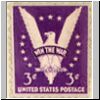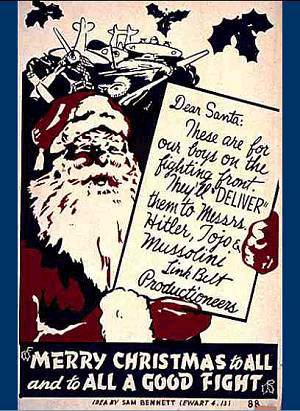And so they did that. Almost everything in the dimestores was Made in Japan,
then. It spilled off all the tables they could find and onto the sidewalk. It was the
height of the Christmas Season 1941, of course, and most of it was Christmas -
including the cardboard houses, tin toys, lights, garlands, unopened cartons of
things - the full contents of the stockrooms. When they were done, the store
was all but bare.
Mid-morning there began a sleeting, freezing bitter rain. People walked by all
day, but there were few takers. Toddlers were attracted, but parents pulled
them back and moved briskly on their way. The stuff just gradually fell apart in
the rain. The manager left it there for that whole week, then hired a truck to
haul it all away .....
The DOLLY TOY CO. .....and ....COLMOR

Ward'sThe Christmas Wishbook 1941:
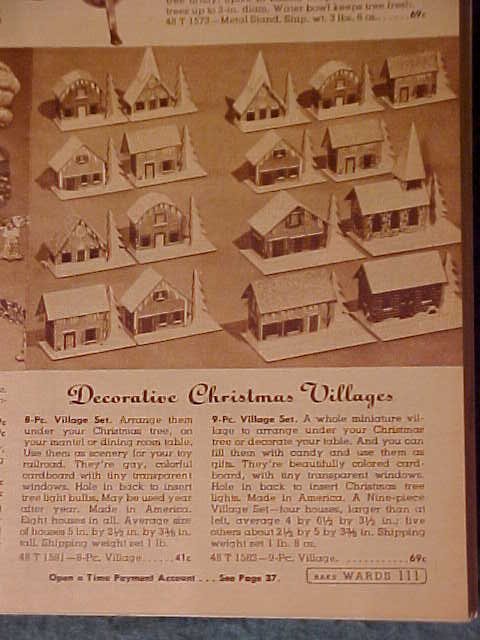
Ward's The Christmas Wishbook 1942:
My current "best-guess" on the debut of Dolly Toy Houses is about 1938. Chronologically,
that would be correct for "Pre-War,", but it isn't right for the feeling of
this period. These American-made mass-produced things are of the War
-they don't fit either aesthetically - or politically - into the innocent Christmas
oppulence of the '30s. They were all you could get for "The Duration"
and years after... up until the mid-'50s when a few large and elborate Japanese
houses made a brief resurgence.
Shown are some "Colmor"printies - not to be
confused with the Japanese "printies" of the late '20's, and some of the
products of the Dolly Toy Company and their "printies."
The creased cardboard trees - replacing the Japanese supply of wound-chenille
trees
from the late '30s - and which are typical American Wartime
and the general manufacturing style would seem to support a Dolly Toy - Colmor"
connection, but they were entirely separate entities. No connection. We
have a fairly good history on Dolly Toy, but try as I may, I can't find much
history on Colmor. They were a two-bit cheap novelty company that made a lot of
cheap things.(Much Like Dolly Toy! - but less documented.) It seemed, at
first, there might be a connection because their
houses are often advertised close together in time - catalog ads of the same years,
and there are some general aesthetic similarities like these which really only
reflect the times during WW II, but it's really only a matter of that and nothing
more.
I don't have a 1940 "wishbook" from either company, but I do have a 1939 Ward's,
and absolutely no houses are offered. None whatsoever. I don't know exactly
when the Dolly Toy Company started making their simpler, best known Christmas
houses, but preWartheir pre-1940 stuff was rather interesting and quite pretty - originally quite
colorful, in soft pastels. If you can find them clean and well preserved, they are
well worth collecting. I think this reflects their innocent beginnings before the
looming War had taken the consciousness of buyers and manufacturers.
From 1941 on, the less fancy Dolly Toy and Colmor are also quite
plentiful - being virtually all that was available during WW II - but hard to
find in nice condition. The inks have faded and grown dull on their printies,
and their method of manufacture with deep die-cuts at the corners and unpainted edges
have given them poor wearing qualities. They come apart after relatively little
handling;
the edges separate and fray. One is lucky to find those which were forgotten and
neglected. Still, if that's what happened to be underneath
your tree as a preschooler (it's what we had) you will want to have some
just the same. The designs were limited in number and detail, but they had
the most charming paper doors and windows!

Selection of <>Pre-1940 Dolly Toy.

When found in like new condition, the preWar DOLLIES can be quite lovely
and worthwhile, with their soft pastel rainbow hues. The texture is very rough:
coarse flint grint - literally coarse flint sandpaper, or very possibly
crushed oyster shell, which was (and still is) extensively used to create
texture in wall paints and plasters.
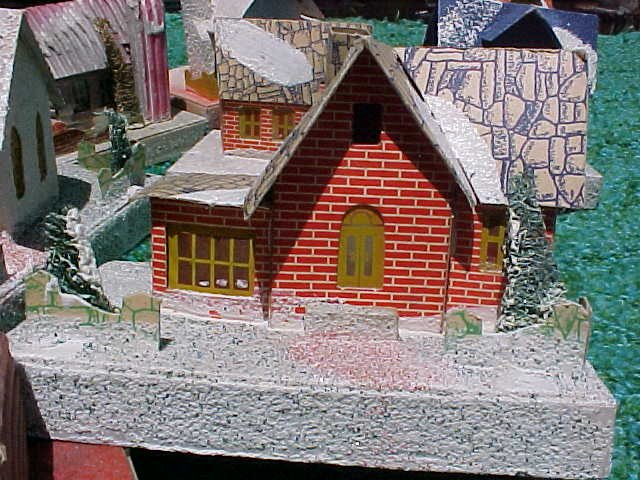
Likewise, in fine condition - Dolly's preWar Printies can be quite nice, too.
Note the windows: ink -either gold or silver - on translucent red tissue, unlike the
WarTime and PostWar two-color lithos on white paper that are so familiar to us
War-Babies.Note, also, that this is EXACTLY the same house as the one in the picture
above, except for the finish.

A fairly representative selection of Dolly Toy and Colmor
WARTIME PRINTIES.
Ca. 1940-'41 until dyeing chemicals came into short supply during The War. I
hear Glenn Miller music whenever I find these. So characteristic and in
harmony with the styles and youthful spirits of that brief time. These really
"swing!"

Dolly Toy, made this basic set of eight in this same box from just before
WW II until they stopped production in the early '50's. This same set of designs can
be found in several finishes, from colored plain tinfoil to glass bead on foil to
multicolor sparkle on plain white cardstock to the absolutely stark, white unadorned
cardstock from the depths of The War, when not even the tinfoil could be spared from
Defense Production. Sets of PRINTIES can also be found in this same box.
Shown are the last of the series: - very late 40's / early '50s - as can be
ascertained from the fact that the bases are styrofoam, rather than the usual
flimsy cardboard open box-style with the corner-rivet staples. Ya gotta forgive them,
they were doing the very best they could. I mean, at $.98/box - how many did they
have to produce to buy a hamburger for their kids?

Typical WarTime piece, of plain white cardstock.
Most everything you could get during WW II was vehemently stamped
"Made in U.S.A." and Dolly Toy was not consistent, but did stamp their
name and address on their pieces and sets often enough to make them one of
three identifiable manufacturers in the history of Christmas village
houses.
Though they hadn't made Christmas village houses in over 50 years, the Dolly
Toy Company just closed their doors in December of 2008.
For their story,
see -
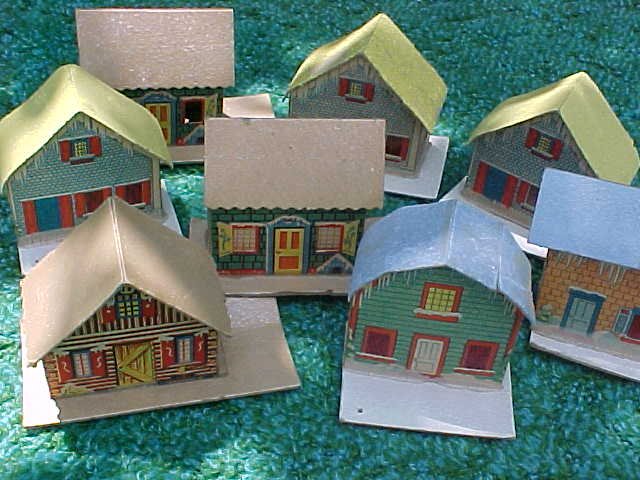
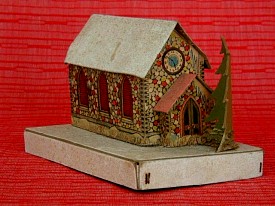

Colmor:
A company called "COLMOR" made these little printies, I am only 99.999% sure.
"Colmor" is a trade name based on the idea of "More color," and there are strong
reasons to believe they were an offshoot of the Dolly Toy Company. The windows are
unlike Dolly Toy, but somewhat like the American "Dollies" is the highly
detailed, if seriously more "kitchy" lithography. You see them in moderately larger
sizes, too. I'm sure they're War-Time. And postwar for a while. They have that early
'40's style, but I really just couldn't prove it... Search engines have produced
many references to a ghost town "Colmor" in New Mexico, but nothing on either
"Colmor" the house maker, or the Dolly Toy Company, while millions of their products
are still to be found at flea markets and in the junk shops. There are features to
be found on both brands that lead me to believe they were made by the same company,
such as the base construction and the characteristic creased cardboard pine trees in
the yard. Incidentally, only "Dolly Toy" and "Colmor" actually used flaked mica to
achieve the "sparkle" effect, which has led many to describe all carboard houses as
"mica," but it wasn't true for any but the American Christmas decorations. The
Japanese used shredded cellophane, natural silicates and ground glass to obtain their
"glitter. " The flaked mica "artificial snow" we shook on our displays and trees
has slowly faded from use, probably because it was such a mess to clean up after.
Tom Hull has contibuted the photos and commentary below. These are
sets he's had in the family since childhood, and although they obtained them just
after The War, these are so typical of what you could get all through
The War as well. Cut-out kits such as the "Merry King Cole and his Fiddlers 3" shown
below are so characteristic of the kind of toys kids got for "the duration"
and for quite a while thereafter.
""The below illustrated houses are marked Colmor on the
backs. These were sold by Sears under their Happi Time brand.No date or even how
many were in the set but the box could have held 9 of these houses. We had a Colmor
set and I believe we got them in 1947. Colmor made a number of cheap toys and
decorations. I have seen ramp walkers, and numerous b-b puzzles and some Easter
stuff including a paper bunny pulling a cart in cardboard and a tin decorated egg
candy containers.

This illustrates the only styles that I have seen that are definitely Colmor.
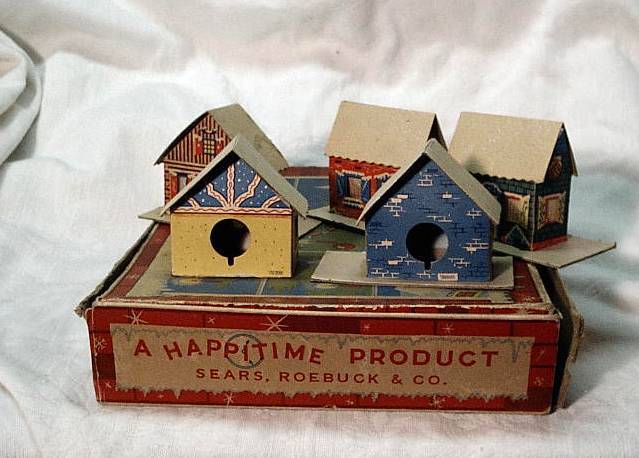

Notice the logo forms sort of a pennant. This appears on the back of all the
Colmor houses." - Tom Hull
It seems that Colmor did make some small tin toys, too. One wonders how they
could have competed with Japan, and during The War they wouldn't have had to. They
seem to have filled a toy-niche' left vacant by the Japanese. Afterwards
I'm sure it was a different story. This probably explains their disappearance.
Thelma Bernard of Las Vegas
sent me this:
"COLMOR:"
"Last night, I spent more time on your
fine website, Ted. Then I checked out
some things on the Internet.
It appears, from what I found in varioius
places, that Colmor, (of Colmor Toys)
stands for Coleman & Morris. I also
ran into Coleman & Morris Inc. They were
listed on one site as being from Port
Chester, New York.
This toy company made tin Easter eggs,
a Bango Band Toy Drum Set,
a Spike Jones Trap Drum Set (1951)
spinning
tin toy tops, a plastic xylophone in the
1950's, and some other tin toys.
Apparently Port Chester, NY through
the years, was known for its iron industry
and I suppose there's enough of a
tie between iron and tin to understand
location.
In any event, perhaps more clues may be
found in "American Tin Litho Toys" by
Lisa Kerr (Collectors Press). I don't have
this book to see if Coleman & Morris is
included as tin toy manufacturers. Perhaps
also in the Ohio Art and Chein collector
books Coleman & Morris may be
mentioned. The books and articles I
have about tin toy manufacturers are too
specialized, mostly on Ohio Art and Chein.
You or one of your vast number of friends
may have tin collectibles books to
research.
Hopefully, this is a lead for you to track
down your mystery cardboard Colmor
houses.
I don't know if the Coleman of Coleman &
Morris is any connection to Coleman
lanterns, or the two sister Colemans in
the doll world.
In any event, to see a Colmor tin top,
please go to the following website:
http://www.geocities.com/topguy.geo/logo.html
When you get on the site, scroll down
past Ohio Art etc. and at the bottom of
the short page, you'll find the Colmor
name and company and you'll see the
top close up by clicking on the thumbnail
photo. Perhaps this "top guy" can tell
you more about the Coleman & Morris
company also.
Hopefully, this is of some help to you." - T.B.
The CLOSE OF WAR:
"CUT and PASTE"
There is a period of two to three years just at the close of
The War that almost needs a category of it's own. The domestic
life remained chaotic for some time. I know my Dad could not get a new car
'till 1948. The War did not end like a movie: it took the rest of the '40s
for things to start to come around. Housing was a huge problem. Perhaps the
preoccupation with so many cut-and-paste assembly sets reflected this. Tom Hull and
I both recall a lot of cut-out-and-assemble toys in our 1940s childhoods.

"The following photos illustrate a pre-cut put together
kit of a set of houses. Many cut-out assembly toys arose during WW II. Though there
is no copyright or date on this I suspect it was probably right after WWII. There
are two different types of kits of these houses. This set is usually referred to as the
"King Cole" set as it features King Cole and his fiddlers three as paper figures as
well as other nursery rhyme characters.

There is one other set and I have it in both built and un-built form. I could get
photos of them to you if you think you could use them
on your site. The other set has the designer name on it but no other info. No
publisher or anything. Curious. These are obviously American made and if I had seen
them when I was a child I would have gone for them in a big way. I was given a
Built-Rite Circus when I was 5 and though I had a hard time getting it together and
wasn't able to get some of the more complicated pieces together I always had a
fascination with anything of this sort. Still do I guess."

- Tom Hull
Even Lionel put out a now-famous-with-collectors Paper Train set
for "The Duration". Engine, cars, track and everything which, by all reports,
was impossible to build. Oddly, you can buy reproductions of this nightmare today.
Cut-out cardboard assembly things were very big in WW II, and this continued all
through the '40s and well into the '50s. I have had considerable debate with myself
whether to assign these things to WW II or "POSTWAR. "Prior to The War there were
always paper dolls and cut-out toys, but Wartime material shortages really set them
into big-time motion, so I've put them here. Just bear in mind they belong equally
to both eras. I know I spent a lot of my 1940's childhood cutting out and pasting
things like this together. Great stuff when you were quarantined at home from school with
the mumps or chickenpox or measels!
CEREAL BOX PREMIUMS
Geez, we ate a lot of cereal to get these things back in the '40s! Remember pasting
quarters to a box top with "Scotch" tape and watching the mailbox forever?
There were two kinds of parents, then: parents of the "upright and solid" kids who
made you eat every box before you got another. Then there was the "spoiled rotten"
type who bought a dozen boxes at a time and fed the contents to the birds just to
lord it over all the rest of us ...
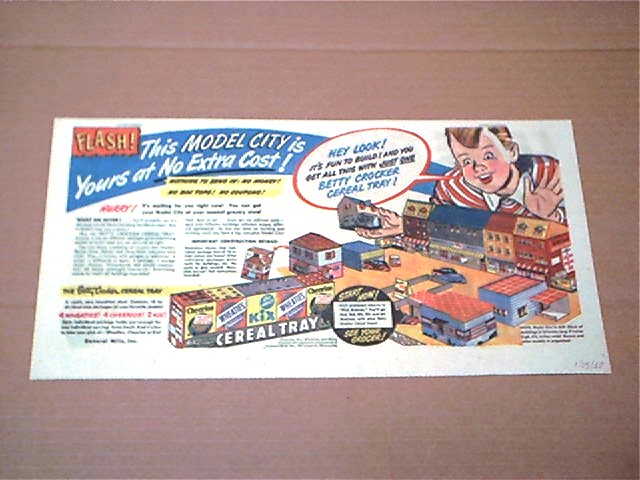
Cereal-box premium houses were a phenomenon of the War and PostWar '40s, too.
At least two cereals issued whole series of little cardboard buildings printed
on the box to cut out and assemble, enough to assemble your own HO scale town!
I don't remember the Betty Crocker series shown above, but both were the same
sort of thing. My strong personal recollection is of those put out by Nabisco
Shredded Wheat. In my kindergarten days(1946/'47), the shredded wheat came in
stocky, squarish boxes with (I think) a dozen large biscuits inside arranged in
layers of 4. The layers were separated by flat sheets of cardboard upon which the
parts for the little buildings were printed. They weren't punched - you had to cut
them out with scissors or razor blades and glue them. It took considerable skill
to do them well. Even so, they were quite popular with kids
and grown-ups alike. These were the days when kids built things! Flying
model airplanes. Crystal sets and one-tube radios. Erector sets and tree houses.
My best-buddy's older brother up the street had an entire ping-pong table
covered with his little city, and you did see them under Christmas trees every
now and then. I have been looking for these at swap meets, antique shows, and
eBay - but have never turned one up.
Nabisco
"TOYTOWN,"
and
"TOYTOWN CARNIVAL" ca. 1946/47:
A new viewer just wrote in with a wealth of information on the
Shredded Wheat village. She gives only her initials:
"T.B. of Las Vegas, NV." - This is her e-mail in it's entirety:
"Hello.
While on an Internet search, I ended up
on your most interesting website and
was reading some things you had to say.
I too recall as a child the Nabisco
Shredded Wheat "dividers" that separated
the pillows of cereal. Apparently various
things were printed on those card
dividers, but the little village series
totally charmed me. Some
years ago, before eBay, I managed to
find a near-complete set of the cards at
a doll show in Las Vegas, NV where I
live.
So: this is to tell you that the "official"
name of these cards is:
"Toytown" -- spelled that way.
Apparently 1947 is when this series
was underway. Each card
is numbered and named. On each
card is a color guide for coloring the
gray cardboard, with instructions on
assembly. The last card of this series,
which is no.36, is titled "Suggested Layout"
and has this wording:

"Here is a bird's eye view of a complete
Toytown. Three cut-out cards in each
package of Nabisco Shredded Wheat.
Duplicate cards will allow greater
variation in setting up your own
Toytown. Start now and join the fun.
Good luck -- and good eating!"
The layout and all cards are "line"
drawings, with enough detail to
carry the concept portrayed.
To give you an idea of size, card no.1
which is titled "Rose Cottage", is 2 13/16's
wide, 1 1/8" deep, and about 2 1/4"
high from bottom to top of chimney
(peaked roof). There are houses
with people printed on them here and
there with some of their pets, a barn,
church, general store, post office,
railroad station, etc. From the
various activities of the people, it
is apparently summer time. One card
is a station wagon -- with wood panel
sides, but the color guide says to
color the wagon "deep yellow".
There are also some trees to cut out
and set up, and several other vehicles
including a bus. There is also a
monument on a base which measures
3 1/8" top to bottom. Anyway, I
thought you may be interested in this
information. I am a person who has
had a life-long delight in miniatures,
and just love train layouts. When I was
a little girl, my uncle had an elaborate
layout for Christmas and it included
some of the glitter-dusted "paper"
houses shown on your site.
It's really nice that you are sharing the
photos (and music!) on a website.
Unfortunately, I'm on webtv. which is
not a computer and I have no access
to anyone with a scanner.
Best wishes to you and yours.
Sincerely,
T.B."
She has provided this link to a fellow who does have a few pictures and more
information:
Thanks, T.B. This is great. Sure wish we had more pictures!

"Unknown" Americans
The "Pineville" Set

I call this The Pineville Set because that is the name on the train station.
There are no other identifying marks on these pieces. Not even country of origin, but I
am 100% sure they are American.

It was 1946. Johnstown, PA. Christmas. The tree and village already up. I was
quarantined at home from kindergarten with measles. (There was a "QUARANTINED!" card
tacked on the front door. They did those things in those days. ) Brother Jim was just
over a year old, crawling and scooting around enough to do real damage. Mom came home
from downtown errands with a set of these. She was delighted as we put them under the
tree - the first replacements she'd been able to get for our plain old wartime
DOLLIES, which had gotten pretty shabby by that time, doors and windows all
punched out by little punchy-fingers (guess who?) -sat on, spilled on and just generally
played to death. I loved 'em!
We had 5 pieces. I didn't discover that more existed (the long, 2-story barn-like
structure in the back row, and 2nd version of the "Chalet"until about ten years ago.)
It's an odd mix, this! You have, on the one hand, thatched-roof English or European farm
buildings, a Swiss "Chalet," and the American comic strip "Lil' Abner"-esque rural comedy
of the General Store and Train Station. The Church could be the stately, stone United
Presbyterian around the corner.
There are no light-holes. No cellophane windows. Just solid cardboard lithos on heavy
cardstock bases.

Can this be anything but American?

....I ask you!

Who made the Pineville Set is a total mystery to me, but here's the set of 8
offered in the 1944 Ward's Christmas Wishbook, establishing absolutely that they were
a definite Wartime thing. How long they may have continued to be offered after the
war is a guess. But for however long, they must sold a lot of them, because you still
find them around here at fleas and antique stores.
Here's a personal from me - I was about 5 at the time these memories were being formed.
That's 1946. Gosh, I am older than the song "White Christmas" that you hear! ('43) - but
I didn't know that; it was the theme of my best Christmases. I am older than "Have
Yourself a Merry Little Christmas", "I'll be home for Christmas," and many more.
God bless us all - I wish it were always 1946 to 1949...The War did fatal damage to the
innocent kind of Christmases we'd had. Things got evermore sped-up and "realistic."
Despite a desperate few years creative fight to get it back, -a handful of now-classic
movies 1947-49 , the bubble lights and brief resurgence of large houses in the 50s, it
was starting to become a thing we hadn't time for. But there is still the music.
The music was the spirit - and remains untouchable no matter how much else we seem
to lose. The just don't write them like that anymore, and it's just not Christmas
without seeing that precious handful of movies for 60th time.. They are the American
Christmas as we like to think it is, but hasn't been for many many years ..

End of WW II Chapter


For information about this site, please contact us at:
http://cardboardchristmas.com/papateds/contact.htm
Copyright 2000-2012 Theodore H. Althof,Jr.Except where noted, the contents of this website and all it's pages and submissions therein contained are the intellectual property of Theodore H.Althof,Jr. All rights are reserved. (Background musical selections are,of course, excepted.)
|
Note: This archive was set up at Ted's request in early 2012, and, except for critical updates and
announcements, will remain exactly as Ted left it in October, 2012.
The archive is kept online with the help of volunteers from:

|

